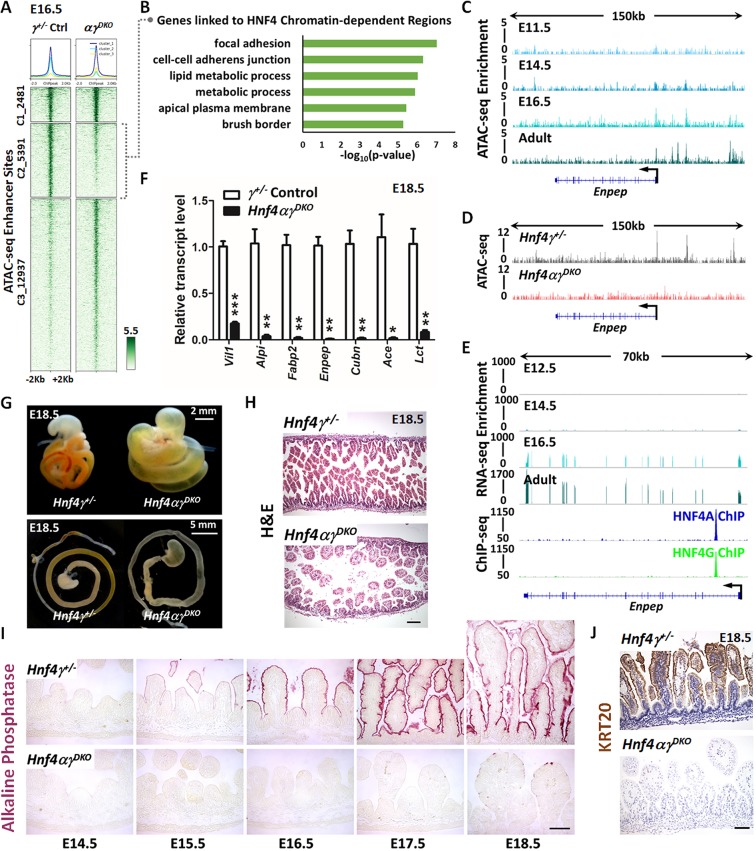Fig. 6.
HNF4 paralogs are redundantly required for fetal maturation of the intestine. (A) K-means clustering of ATAC-seq data collected from E16.5 intestinal epithelial cells isolated from Hnf4αγDKO and control embryos identify 5391 regions (cluster 2) that are dependent on HNF4 factors for chromatin accessibility (n=2 biological Hnf4αγDKO replicates and 1 Hnf4g+/− control in this study; MACS P value ≤10−5). (B) Functional annotation of the genes linked to HNF4-dependent accessible chromatin by DAVID. Genes with transcriptional start sites within 20 kb of ATAC-seq sites of cluster 2 (loss of chromatin accessibility upon HNF4 loss) from A were used for analysis. (C-E) Examples of chromatin accessibility at HNF4-dependent ATAC-seq sites are visualized using IGV. (C) ATAC-seq (GSE115541) shows a time-dependent increase of chromatin accessibility at the locus of the brush border gene Enpep from E11.5 embryo to adult. (D) ATAC-seq shows compromised chromatin accessibility at the Enpep locus in E16.5 Hnf4αγDKO. (E) RNA-seq (GSE115541) shows corresponding increase in transcript levels of Enpep over developmental time. HNF4A and HNF4G directly bind to Enpep (GSE112946, ChIP-seq panel), suggesting direct regulation. (F) qPCR shows that the transcript levels of genes known to be expressed in the mature intestine are dramatically reduced in isolated E18.5 intestinal epithelial cells from Hnf4αγDKO compared with those from littermate Hnf4g+/− controls. Data are presented as mean±s.e.m. (n=4 controls and 5 mutants, Student's t-test, two-sided at ***P<0.001, **P<0.01 and *P<0.05). (G) Whole mount images of E18.5 intestine indicate that loss of HNF4 paralogs leads to an underdeveloped intestine with distended and translucent lumen (representative of six biological replicates). (H) Strikingly stunted villi are observed in E18.5 Hnf4αγDKO embryos compared with littermate Hnf4g+/− controls, as revealed by H&E staining (representative of four biological replicates, E18.5 duodenum; see expanded panel in Fig. S3D). (I) Hnf4αγDKO exhibits diminished alkaline phosphatase staining (differentiation marker) across developmental time (representative of four biological replicates; E14.5-E18.5 duodenum). (J) Keratin 20 immunostaining also indicates compromised intestinal differentiation in Hnf4αγDKO embryos (representative of four biological replicates; E18.5 duodenum). Scale bars: 50 μm in H,I,J. See Figs S2 and S3 for additional metrics of intestinal maturation.

